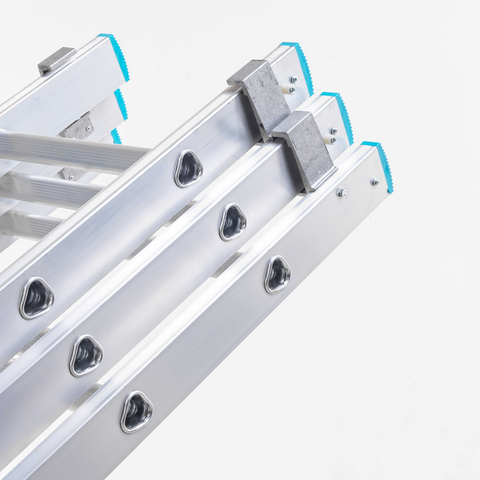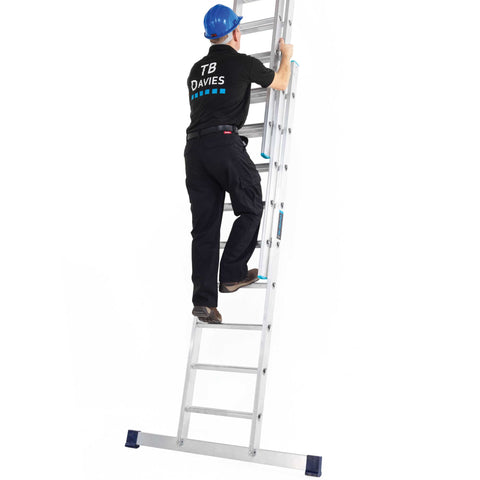What never fails to amaze visitors to our manufacturing site in Lewis Road, Cardiff, is the huge range of ladders we keep in stock. No one usually thinks about all the different ladders you can buy. Most of us know some types, including extending, step, and loft ladders, but there’s so much more. We’ve got almost every imaginable type of ladder, from small to tall. But today, we’re looking at extension ladders and asking what is an extension ladder?
This guide will look at what makes an extension ladder a must-have in the toolkit of anyone working at height.

Understanding Extension Ladders
A traditional ladder is a one-piece section with two side rails or stiles and some rungs spaced equally along the full length. To make this more useful, additional sections are added to make either a double or triple-section extension ladder. An extension ladder aims to get you to a high point, such as the eaves of your roof line or guttering level. An extension ladder is a handy tool for most homeowners. An extension ladder, by definition, is a ladder that can be extended to reach higher points than its storage length would allow. It consists of two or more sections that slide out and lock into place, enabling the user to adjust the ladder’s height by rung-level increments. This adjustability makes the extension ladder useful and suitable for tasks ranging from painting and cleaning gutters to accessing roofs and performing tree trimming.

When storing an extension ladder, triple-section ladders are shorter and easier. Bear this in mind when you’re looking to buy one, as some of our longer ladders, especially the 5m or 5.5m ladders, need a long yard to store them when they aren’t in use. It would help if you always made sure that the ladders are secured when you’re not using them. Otherwise, they can be stolen or used to break into your home. The extension ladder is probably the most important tool for many tasks, from home maintenance to professional construction projects.
The Anatomy of an Extension Ladder
Key components of an extension ladder include:
- Rails or Stiles: These are the sides of the ladder
- Rungs: The horizontal round or ‘D’-shaped rungs that are spun into the sides of the ladder
- Fly Section: The movable part of the ladder, or top 1 or 2 sections that slide out to extend its length.
- Base Section: The first section of the ladder that remains in contact with the ground.
- Stabiliser Bar Section: To prevent sideways movement, a stabiliser bar must be fitted to the feet of the ladder before use. This helps prevent falls from height
- Rung Locks: Mechanisms that secure the top sections stay in place once extended.
- Rope and Pulley System: Usually found on heavy-duty/industrial ladders that help users extend the ladder fully. These are no longer common on DIY or Trade extension ladders.
Materials and Durability
Extension ladders are now only found in aluminium, but specialist fibreglass extension ladders, are used almost exclusively by electricians or the telecoms industry. Aluminium extension ladders are typically all you will find in a hardware store or online.
- Aluminium ladders are lightweight and resistant to corrosion, making them ideal for general use. However, they conduct electricity and are not suitable for electrical work.
- Fibreglass ladders are durable, non-conductive, and suited for electrical tasks, but they are specialist and will be more expensive.
Choosing the Right Extension Ladder
When selecting an extension ladder, consider the following factors:
- Height: The extension ladder should extend at least 3 feet over the working surface for stability. For example, when getting onto your roof, the ladder needs to continue for at least 3 feet /1m past the contact point so that you have a handhold to help you get off safely onto the roof. And you’ll have a safe access point to catch onto when coming off the roof and back onto your ladder. You need to calculate this additional length when buying a ladder that will fit.
- Weight Capacity: Ladders are rated by their maximum load capacity, including the weight of the user plus any tools or materials. Ladders sold on ladders-online all conform to EN131, which states that the workload capacity is 150kg.
Safety Considerations
Using an extension ladder safely is paramount to prevent falls and injuries. Key safety tips include:
- Always place the ladder on a stable, level surface
- Follow the 4-to-1 rule for placement: For every 4 feet of ladder height, move the base 1 foot away from the wall
- Ensure the locks are securely engaged before climbing
- Maintain a 3-point contact (two hands and one foot or two feet and one hand) while on the ladder
- Do not overreach; moving the ladder when necessary is safer. Keep your belt buckle within the ladder's sides; don’t go beyond. Move the ladder and re-climb
- Don’t use aluminium ladders for electrical work due to their conductivity. Look to buy fibreglass extension ladders instead.
Maintenance and Storage
Proper maintenance and storage extend the life of an extension ladder:
- Regularly inspect the ladder for wear, damage, or corrosion, especially before use
- Keep the rungs clean and free of slippery materials. Wipe any oil off the ladder, and make sure it isn’t covered in paint. Otherwise, you won’t be able to see any cracks or tears that could affect the ladder's strength
- Lubricate moving parts as needed to ensure smooth operation
- Store the ladder in a dry, sheltered place to prevent weathering and warping, and secure it with a lock, or better still, use our ladder storage brackets to keep it locked off the floor.
An extension ladder is a useful, essential tool for professionals and homeowners. You can use it for various purposes, from simple household tasks like painting, decorating, or hanging Christmas lights to various construction projects. Now, you will better understand what an extension ladder is and the sorts of jobs it can do. You understand the terminology and what to look out for when buying an extending ladder. But if you have any questions, no matter how simple or specific, write away in our comments box below.


